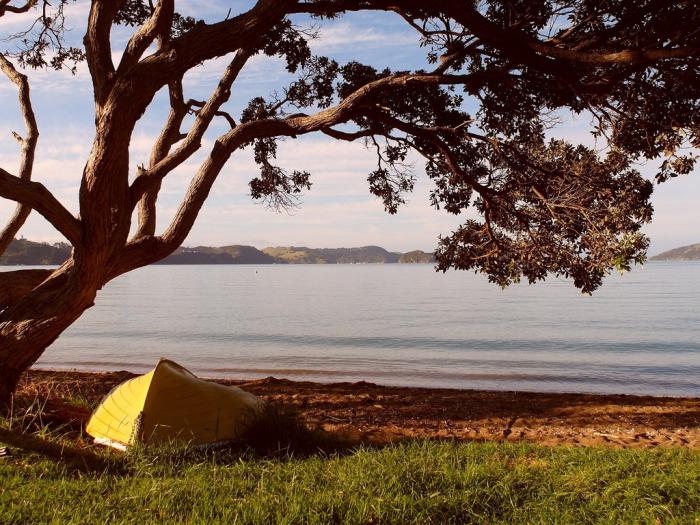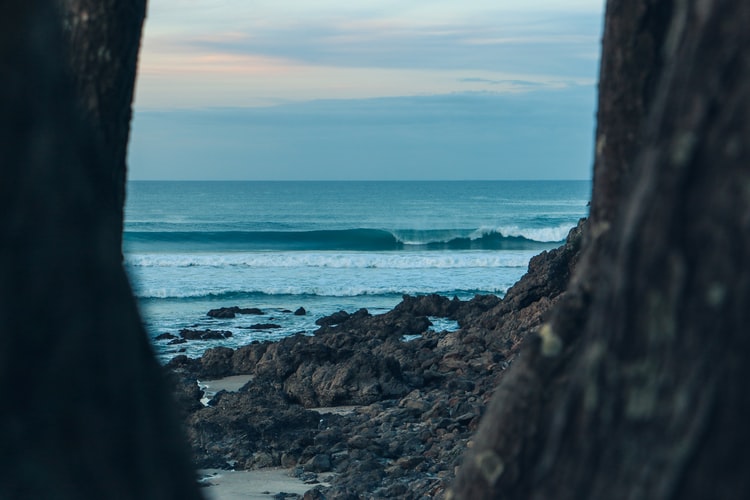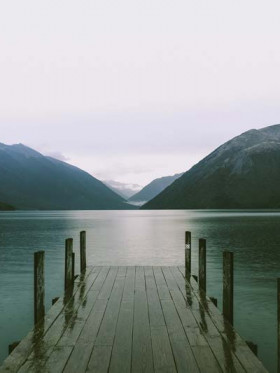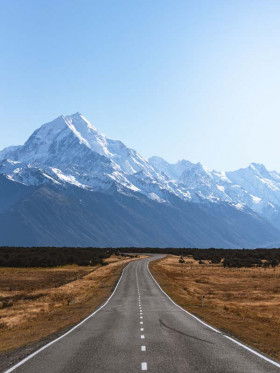Auckland City is the biggest city in New Zealand, containing within its sprawling city regions about a quarter of the total population of our small nation.
Aucklanders are referred to, by the rest of the country, as JAFAs - a not so nice acronym which I’ll leave you to research on your own. It succinctly sums up what the rest of the country think of Aucklanders: latte drinking, suitcase carrying, designer clothes wearing snobs. In bygone years, if you lived North of the Auckland Harbour Bridge, or South of the Central City, you had the honour of NOT referring to yourself as a JAFA, as there were multiple small districts, independent of the big city. That all changed in 2010 when the Auckland Council decided to create a “Super City” and swallowed up all those smaller districts. So, Auckland became even more massive.
Now if you’re thinking of Auckland as just one big concrete jungle; a place to steer your campervan away from, or put the pedal to the metal and speed on through, you’d be doing yourself a massive disservice. On the outskirts of this multi-cultural metropolis lies a veritable treasure chest of spectacular natural beauty; jaw-droppingly gorgeous landscapes; some of the best beaches in NZ; and some absolutely breathtaking regional parks and nature reserves for you to hike through in search of hidden waterfalls (of which there are dozens).
Any direction you go in; whether it be North, South, East or West, has something special and unique to offer. So my advice to you nature-loving campervan travellers out there: by all means, head on down the highway, throw a glance at our phallic Sky Tower on the way through and head out to the fringes of the Auckland region to enjoy some of the best NZ has to offer.
North
Te Arai Regional Park
 What does Te Arai have to offer? What DOESN’T it have to offer? A gorgeous surf beach - yet just around the corner is a slightly calmer bay for swimming; lake ecosystems, wetlands, coastal broadleaf forest.
What does Te Arai have to offer? What DOESN’T it have to offer? A gorgeous surf beach - yet just around the corner is a slightly calmer bay for swimming; lake ecosystems, wetlands, coastal broadleaf forest.
There’s a bookable campground nearby, so you can set up your campervan spot before heading to the beach to soak up some of NZ’s famously powerful rays, or go for a leisurely stroll through farmland and bush to spot some of the native birdlife. Alternatively, choose an overnight campervan parking spot with a beach view from which to launch yourself out into the great landscapes!
Added bonus: when you’ve had enough of Te Arai (if ever!) it’s only a short drive further north to Mangawhai and the Mangawhai Heads, fantastic settlements with yet more white sand, clear surf beaches. Or head south to Omaha for a gorgeous, well-patrolled beach and funky town. In fact, you could probably just keep driving up or down that coastline for days, stopping at every beach, eating ice-creams, camping in deserted DOC (Department of Conservation) campsites in the forest or on the beach.
The Hibiscus Coast
A bit closer to Auckland City (only about 35 minutes’ drive - but make sure you don’t attempt this between the hours of 3 and 6 on a weekday!) you will find the Hibiscus Coast, also known as the Whangaparaoa Peninsula.
Jutting out from the holiday/retirement haven of Orewa (which, contrary to derogatory comments from JAFAs, is actually a character-filled, well designed, pleasant wee coastal town to base yourself in), there is only one main road that winds its way to the tip of the Peninsula. This leads to yet another stunning regional park (Shakespeare regional park) with safe swimming beaches, bush and farm hikes, and a gorgeous beachside campground to call home.
The Hibiscus Coast is special because although it’s rather small, there are about a dozen beaches to choose from: so even on the busiest of summer days, you will have no trouble finding yourself a clear bit of sand or a pohutukawa tree to plop yourself under. If one beach is too busy, jump back in the motorhome and cruise to the next one. You could make a week out of it and challenge yourself to do a beach a day - that’s if you’re a beach lover of course. If that doesn’t float your boat, the Hibiscus Coast is still well worth a visit. There’s kayaking in the local estuary, a multitude of bush walks to choose from, ice-cream shops on every corner, and a relaxed, welcoming vibe that you’d be hard pressed to find in Auckland City itself.
West
Whereas the east coast is all about sparkling blue water and white sand perfect for your Instagram feed, the west coast is definitely wild. Famed for the black volcanic sand beaches (you’ll want to wear your jandals when visiting here in summer, trust me), and wild surf pounding in from the Tasman Sea. Even the drive to most beaches is a wee bit wild, but stunning nonetheless. Many of the popular beaches are reached through very windy roads with sharp curves that cut through some gorgeous NZ bush.
Muriwai
 Although you really can’t go wrong with any of the west coast beaches, my top pick for nature lovers is Muriwai beach. This is because they have a fabulous cliff-top gannet colony. It’s an easy walk to the top of the cliffs, where you can literally stand right beside and above the colony of about 1200 gannet pairs. Watching them take off and land in the often strong winds here is a miracle of nature. And if you come at the right time of year you can marvel at how the parent bird manages to find it’s squawking furry chick amongst the hundreds of other squawking furry chicks!
Although you really can’t go wrong with any of the west coast beaches, my top pick for nature lovers is Muriwai beach. This is because they have a fabulous cliff-top gannet colony. It’s an easy walk to the top of the cliffs, where you can literally stand right beside and above the colony of about 1200 gannet pairs. Watching them take off and land in the often strong winds here is a miracle of nature. And if you come at the right time of year you can marvel at how the parent bird manages to find it’s squawking furry chick amongst the hundreds of other squawking furry chicks!
Muriwai, of course, has a fab surf beach, where you can give it a go at the local surf school, or take a meander along the coastal boardwalk and check out some of the wildlife. If you’re lucky, you may even see a fur seal taking some time out on the beach.
And in true kiwi style, of course, there’s a campground right on the beach, where you can end your salty day with a coffee, watching the gannets fly in and the surfers battle those epic waves. As with the northern beaches, I would advise giving yourself at least a few days, if not a week, to cruise around all these special west coast beaches: from beach campsite to forest campsite. Stop at your leisure and explore this unique environment: start from the rugged Karekare beach, visit the gorgeous long Piha beach with its iconic Lion Rock, then stop by Anawhata and Bethell’s Beach on your way up to Muriwai.
Lake Wainamu (or Bethell’s Lake)
Although nearby Bethell’s beach is definitely worth adding to the list, this lake is unmissable. It’s a wee bit of a hidden secret, but a fantastic way to spend the day. En-route to Bethell’s beach, park up in the carpark on Bethell’s Road, next to the bridge crossing the Waiti Stream. From there you can follow the Lake Wainamu Track alongside the stream. Then you can either continue to follow the stream to reach the lake or take the slightly more arduous (and foot burning) route of heading up over the sand dunes. These sand dunes are massive, even though the beach is a wee way away. They are a result of sand being blown and deposited here by the powerful west coast winds. In the midst of the dunes, with the forest covered hills surrounding you, it’s easy to feel like you’re in an alien environment, with the contrasting landscapes. Then, just when you think your thighs can’t take it anymore, you will catch a glimpse of a gorgeous lake at the foot of the dunes, surrounded by bush, looking a lot like an oasis in the desert. Bring water and food because there isn’t a shop in sight!
There’s a fantastic bush walk that circles around the lake, where you can see bird life, particularly a lot of waterfowl. And if you follow the path further upwards behind the lake, you will find an absolutely gorgeous series of waterfalls and swimming holes to spend the day cooling off in. Your own private paradise. Campgrounds are nearby at Karanga, and Bethell’s is a great place to kick off your exploration of all the west coast beaches.
South
The Awhitu Peninsula
Head south for a bit of adventure at the black sand beach of Karioitahi. This windswept expanse of the beach makes it ideal for sand and water sports like hang gliding, paragliding, blokarting (yes that’s a thing!), surfing, 4-wheel driving, horse riding and more. For a more tranquil ocean experience, park up at the Awhitu Regional Park to enjoy the safe, white-sand beaches and rolling hills. If it’s all a bit too much, you can sit back and appreciate the stunning harbour views from the local cliffside winery. The Peninsula Campground is smack bang in the middle of the park, so you have a great home base from which to explore.
East
The Pohutukawa Coast

Touted as one of the most stunning coastlines in the region, it’s well worth a drive along this part of Auckland. If you time your visit to December/January, you will get the full effect of the pohutukawa: the Kiwi Christmas tree - a stunning native tree which is covered in brilliant red blooms during the Christmas period, usually found along the coastline.
Pack your togs (swimsuit) and jandals (flip flops), buy some ‘fish n chips’ and a bottle of ice-cold L&P, and you're all set for a true kiwi road trip. Visit the Omana Regional Park with its safe swimming beach and barbecues: it even comes complete with some friendly farm animals if you like the idea of communing with nature. Visit Maraetai beach, or park up and explore the expansive green hills of the Duder Regional Park, where you will walk through pastures full of sheep - a true kiwi experience. Campsites are available at Omana, Opoutere, and Duder’s Park.
The Hunua Ranges

A huge area of southeastern Auckland is occupied by the Hunua Ranges. These forest covered hills come complete with crystal clear streams, stunning waterfalls, and gorgeous vistas. At 400 square km, the Hunua park is the largest native forest area within the Auckland region. There are fabulous walks through the bush, past the Hunua Falls, up around the Hunua basin and dams (large water catchment areas for the Auckland region). The forest contains more than 450 species of native plants. If walking is too slow for you, there are three mountain bike trails to add some excitement to your bush experience! If you want to stay in this patch of forest paradise (only an hour from the city), check out Upper Mangatawhiri Campground as your base. Or continue on down south to hit the Coromandel Peninsula, another unmissable road trip!





